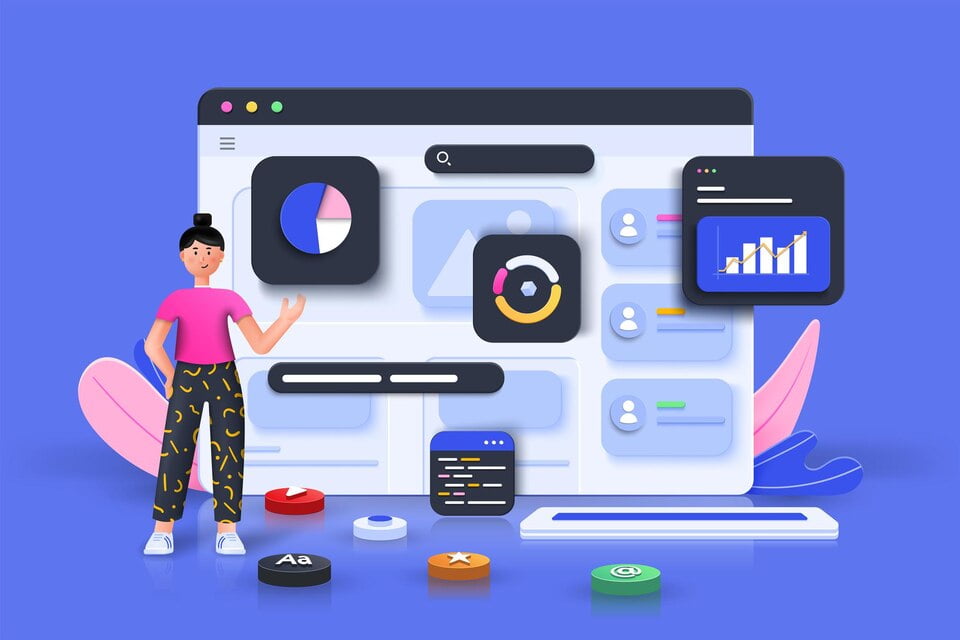Welcome to our comprehensive guide on how to calculate engagement rate. It’s crucial to accurately measure your engagement rate to understand how well your audience is interacting with your content on social media and other platforms. By understanding the engagement rate formula and the key components involved, you can effectively gauge the success of your online presence and make informed decisions to improve your interaction strategies.
Measuring engagement is more than just a vanity metric. It provides valuable insights into the effectiveness of your content and allows you to foster meaningful connections with your audience. By analyzing engagement rate metrics, you can identify areas of improvement and optimize your online presence to strengthen engagement.
In this article, we will explore the various components and formulas for calculating engagement rates, taking into account different social media platforms and websites. We will also provide you with best practices, case studies, and recommended tools to help you consistently measure and improve your engagement rate.
Whether you’re an individual looking to build a personal brand or a business aiming to grow its online presence, understanding how to calculate engagement rate is essential. So, let’s dive in and discover the strategies and insights that will enable you to accurately measure and leverage your engagement rate for overall success.
Table of Contents
Why Calculate Engagement Rate?
Understanding the importance of calculating your engagement rate is key to evaluating the success of your online presence. By measuring your engagement rate metrics, you gain valuable insights into the level of interaction your audience has with your content. This metric goes beyond mere follower counts and provides a true representation of the effectiveness of your online strategies.
Improving your engagement rate is essential for building a strong connection with your audience. A high engagement rate signifies that your content resonates with your target audience, leading to increased brand awareness, customer loyalty, and even conversions. By analyzing and improving your engagement rate, you can refine your content strategy, tailor your messaging, and strengthen your overall online presence.
Engagement Rate Metrics
When calculating your engagement rate, there are several key metrics you need to consider:
- Likes: The number of likes your posts receive indicates the level of interest and appreciation from your audience.
- Comments: Comments reflect the level of engagement and interaction with your content, showcasing the extent to which your audience is actively participating in the discussion.
- Shares: Shares demonstrate that your content is valued enough to be shared with others, expanding your reach and exposing your brand to a wider audience.
- Click-throughs: The number of click-throughs on your links indicates the effectiveness of your call-to-action and the audience’s willingness to explore further.
By tracking and analyzing these engagement rate metrics, you can gain a deeper understanding of your audience’s preferences, behaviors, and level of involvement. Armed with this data, you can make data-driven decisions to improve your content and engagement strategies, ultimately fostering stronger connections with your audience.
| Metric | Description |
|---|---|
| Likes | The number of likes your posts receive indicates the level of interest and appreciation from your audience. |
| Comments | Comments reflect the level of engagement and interaction with your content, showcasing the extent to which your audience is actively participating in the discussion. |
| Shares | Shares demonstrate that your content is valued enough to be shared with others, expanding your reach and exposing your brand to a wider audience. |
| Click-throughs | The number of click-throughs on your links indicates the effectiveness of your call-to-action and the audience’s willingness to explore further. |
Key Components of Engagement Rate

Calculating engagement rate involves considering various factors specific to each social media platform, such as Instagram and Facebook. Understanding the key components of engagement rate measurement on these platforms is essential for accurately assessing your audience’s interaction and sentiment toward your content.
To calculate the engagement rate on Instagram, you need to take into account the following key components:
- likes
- comments
- shares
- saved posts
- clicks on profile
Each interaction contributes to the overall engagement rate, providing valuable insights into how your audience is engaging with your content on Instagram.
When calculating the engagement rate on Facebook, the key components to consider are:
- likes
- comments
- shares
- clicks on posts
- clicks on links
- reactions (such as “love,” “haha,” “wow,” etc.)
These components collectively determine the level of engagement your audience has with your Facebook posts.
| Component | Description |
|---|---|
| Likes | Indicates the number of times your post has been liked. |
| Comments | Shows the number of comments left by users on your post. |
| Shares | Represents the number of times your post has been shared by users. |
| Saved Posts | Reflects the number of times users have saved your post for future reference. |
| Clicks on Profile | Shows the number of times users have clicked on your profile after viewing your post. |
| Clicks on Posts | Indicates the number of times users have clicked on your Facebook posts. |
| Clicks on Links | Represents the number of times users have clicked on links shared in your Facebook posts. |
| Reactions | Shows the number of different reactions (such as “love,” “haha,” “wow,” etc.) received on your Facebook posts. |
By understanding and carefully analyzing these key components, you can gain deeper insights into how your audience interacts and engages with your content on Instagram and Facebook, allowing you to make informed decisions to enhance engagement and build a stronger online presence.
How to Calculate Engagement Rate

To accurately calculate your engagement rate, you need to utilize a specific formula. Understanding this formula is critical for evaluating the success of your online presence. Let’s dive into the engagement rate formula and explore how each component contributes to the overall calculation.
Engagement Rate Formula:
| Component | Description |
|---|---|
| Total Engagements | The total number of engagements on a specific platform, such as likes, comments, shares, and clicks. |
| Reach | The total number of unique users who have seen your content. |
| Impressions | The total number of times your content has been displayed. |
| Engagement Rate | The percentage of users who engaged with your content out of the total number of users who were exposed to it. |
By plugging in the values for total engagements, reach, and impressions into the engagement rate formula, you can calculate your engagement rate as a percentage. This metric provides valuable insights into the effectiveness of your content and helps you gauge the level of audience interaction.
Now that you have a grasp of the engagement rate formula, you can accurately measure and analyze your engagement rate, paving the way for data-driven decision-making and improved online interaction strategies.
Calculating Engagement on Social Media
Calculating the engagement rate on social media platforms is a crucial step in understanding the effectiveness of your online presence. By accurately measuring and analyzing your engagement, you can optimize your strategies to strengthen your connection with your audience. In this section, we will explore different methods, tools, and best practices for calculating engagement on social media.
Different Methods for Measuring Engagement
When it comes to measuring engagement on social media, there are several methods you can use to calculate your engagement rate. These methods provide insights into how your audience interacts with your content and help you assess the success of your engagement efforts. Some common methods include:
- Likes and Reactions: Tracking the number of likes and reactions your posts receive.
- Comments: Monitoring the number of comments and replies on your posts.
- Shares and Retweets: Measuring the number of times your content is shared or retweeted.
- Click-through Rates: Evaluating the percentage of users who click on links shared in your posts.
- Followers and Subscribers: Monitoring the growth and engagement of your follower and subscriber base.
Tools for Measuring Engagement Rate
To simplify the process of calculating and analyzing your engagement rate, there are various tools available that provide comprehensive insights. These tools offer valuable metrics and analytics to help you evaluate your engagement performance and make informed decisions. Some popular engagement rate tools include:
- [Tool Name]: This tool provides in-depth engagement metrics, allowing you to track likes, comments, shares, and more.
- [Tool Name]: With this tool, you can monitor your audience growth, engagement, and click-through rates, as well as compare your performance against competitors.
- [Tool Name]: This tool offers advanced analytics and customizable reports to help you analyze engagement across multiple social media platforms.
By leveraging these tools and techniques, you can effectively measure and analyze your social media engagement, enabling you to refine your strategies, optimize your content, and foster meaningful interactions with your audience.
Measuring Engagement on Websites

While social media plays a significant role in the overall engagement rate, it’s equally important to measure engagement on your website. By understanding how to calculate engagement and interactiveness on your website, you can gain valuable insights into visitor behavior and optimize the user experience.
To calculate engagement on your website, consider the following key metrics:
- Page views: The number of times a page has been viewed.
- Unique visitors: The number of individual users who have visited your website.
- Time on page: The average amount of time users spend on a particular page.
- Bounce rate: The percentage of visitors who leave your website after viewing only one page.
- Conversion rate: The percentage of visitors who complete a desired action, such as making a purchase or filling out a form.
By analyzing these metrics, you can determine the level of engagement your website is generating and identify areas for improvement. For example, a high bounce rate may indicate a need for better page navigation or more engaging content. Conversely, a low conversion rate may highlight the need for clearer calls to action or streamlined checkout processes.
Optimizing User Experience
In addition to measuring engagement, it’s essential to optimize the user experience on your website. A seamless and user-friendly interface can significantly impact engagement levels. Consider the following strategies:
- Responsive design: Ensure your website is mobile-friendly to accommodate users accessing it from various devices.
- Fast loading speed: Optimize your website’s loading time to prevent users from getting frustrated and leaving.
- Clear navigation: Make it easy for visitors to find the information they’re looking for by implementing intuitive navigation menus.
- Compelling content: Create relevant and engaging content that captures visitors’ attention and encourages them to explore further.
- Interactive elements: Incorporate interactive features, such as quizzes, polls, or live chat, to encourage active participation and prolong user engagement.
By prioritizing user experience and proactively addressing areas for improvement, you can create a website that fosters higher engagement levels and drives meaningful interactions with your audience.
| Metric | Definition |
|---|---|
| Page views | The number of times a page has been viewed. |
| Unique visitors | The number of individual users who have visited your website. |
| Time on page | The average amount of time users spend on a particular page. |
| Bounce rate | The percentage of visitors who leave your website after viewing only one page. |
| Conversion rate | The percentage of visitors who complete a desired action, such as making a purchase or filling out a form. |
Interpreting Engagement Rate Metrics
Once you have calculated your engagement rate, it’s crucial to interpret the metrics accurately. This section will guide you through the various engagement rate metrics and their implications, helping you make informed decisions to improve your overall engagement.
Engagement Rate Metrics
Understanding the different engagement rate metrics is essential to gain insights into your audience’s interaction with your content. By analyzing these metrics, you can identify areas of improvement and tailor your strategies to increase engagement. Here are some of the key engagement rate metrics:
- Number of likes and reactions
- Number of comments
- Number of shares and retweets
- Number of clicks and conversions
- Time spent on page
Different platforms may have additional engagement rate metrics specific to their features. It’s important to have a comprehensive understanding of these metrics to accurately evaluate your engagement rate.
Implications and Analysis
Each engagement rate metric provides valuable insights into your audience’s behavior and preferences. By analyzing these metrics, you can assess the effectiveness of your content and make data-driven decisions to improve your engagement rate. Here are some key implications of engagement rate metrics:
- A high number of likes and reactions indicate that your content is resonating with your audience.
- An increased number of comments suggests that your content is sparking discussions and engaging your audience.
- A high number of shares and retweets indicates that your content is deemed valuable and shareable by your audience.
- A higher number of clicks and conversions shows that your audience is taking action based on your content.
- A longer time spent on the page indicates that your content is engaging and holding your audience’s attention.
Understanding the implications of these metrics allows you to identify patterns, trends, and areas for improvement. By analyzing the data, you can optimize your content strategy to drive higher engagement and achieve your goals.
| Metric | Implication |
|---|---|
| Number of likes and reactions | Your content resonates with your audience, indicating a positive response. |
| Number of comments | Your content sparks discussions and encourages audience engagement. |
| Number of shares and retweets | Your content is valuable and shareable, extending your reach and increasing brand visibility. |
| Number of clicks and conversions | Your content motivates your audience to take action, leading to desired outcomes. |
| Time spent on page | Your content is engaging and holds your audience’s attention, increasing the likelihood of conversions. |
Tools for Measuring Engagement Rate
To streamline the process of calculating and analyzing engagement rates, there are several top-notch tools and software available. These engagement rate measurement tools empower you to efficiently track and optimize your engagement, allowing you to make data-driven decisions to improve your online presence and connect better with your audience.
1. Social media analytics platforms:
Social media analytics platforms like Sprout Social and Hootsuite provide comprehensive insights into engagement metrics across multiple social media channels. These tools allow you to analyze likes, comments, shares, and other relevant engagement metrics, helping you gain a holistic understanding of your audience’s interaction with your content.
2. Google Analytics:
Google Analytics is a powerful and versatile web analytics tool that can be used to measure engagement on your website. It enables you to track user behavior, such as time spent on a page, bounce rate, and conversion rate, providing valuable insights into how visitors engage with your site.
3. Email marketing platforms:
Email marketing platforms like Mailchimp and Constant Contact offer engagement tracking features that allow you to measure open rates, click-through rates, and other relevant metrics. These tools enable you to assess the effectiveness of your email campaigns and optimize your messaging to increase engagement.
4. Survey tools:
Survey tools like SurveyMonkey and Typeform can be used to collect feedback and measure customer satisfaction, which indirectly reflects engagement. By analyzing survey results, you can gain insights into how engaged your customers are and identify areas for improvement.
These are just a few examples of the many engagement rate measurement tools and software available. Depending on your specific needs and platforms, you can choose the tools that best suit your requirements. By leveraging these tools, you can effectively measure and analyze your engagement rate, enabling you to make data-driven decisions and optimize your online interactions for maximum impact.
Best Practices for Improving Engagement Rate
To effectively improve your engagement rate, it’s crucial to implement proven strategies and best practices. By employing the following tips and techniques, you can foster meaningful interactions with your audience and boost your overall engagement.
1. Create Compelling and Relevant Content
One of the key drivers of engagement is high-quality content that resonates with your target audience. Take the time to research their interests, pain points, and preferences, and create content that addresses their needs. Ensure your content is informative, entertaining, and valuable, offering insights and solutions that keep your audience engaged and coming back for more.
2. Encourage Audience Participation
Engagement is a two-way street. Encourage your audience to actively participate by asking questions, running polls or surveys, and seeking their opinion. Make it easy for them to engage by providing clear calls to action that prompt them to like, comment, and share your content. Respond to their comments and messages promptly, showing that you value their input and fostering a sense of community.
3. Optimize Your Content for Different Platforms
Each social media platform has its unique features and requirements. To improve your engagement rate, tailor your content to suit each platform. Use eye-catching visuals on Instagram, share bite-sized tips and quotes on Twitter, and create longer-form content on your blog or YouTube channel. By optimizing your content for each platform, you’ll be able to better engage with your audience and drive higher interaction.
4. Leverage the Power of Visuals
Visual content grabs attention and drives engagement. Incorporate compelling images, videos, gifs, and infographics into your posts to make them visually appealing and shareable. Use high-quality visuals that align with your brand and message, and ensure they are optimized for the platform you’re using. Visuals not only make your content stand out, but they also evoke emotions and compel your audience to take action.
| Best Practice | Description |
|---|---|
| Use Consistent Branding | Establish a cohesive brand identity across all your platforms to create a recognizable and memorable presence. Use consistent colors, fonts, and messaging to reinforce your brand image and build trust with your audience. |
| Post Regularly and Consistently | Develop a consistent posting schedule to keep your audience engaged and establish a reliable presence. Experiment with different posting frequencies and times to determine what works best for your audience. |
| Utilize Hashtags | Hashtags can expand your reach and attract new followers. Research relevant hashtags in your industry or niche and include them in your posts to increase discoverability. Create your own branded hashtags to encourage user-generated content. |
| Analyze and Learn from Data | Regularly analyze your engagement metrics to gain insights into what content resonates with your audience. Identify trends, patterns, and areas for improvement, and adjust your content strategy accordingly. |
By following these best practices, you can improve your engagement rate and build a loyal and active community of followers. Remember, engagement is about creating meaningful connections with your audience, so always prioritize quality over quantity.
Case Studies: Successful Engagement Rate Strategies
When it comes to boosting engagement, there’s no better way to gain insights and inspiration than by analyzing real-life case studies. In this section, we will delve into a selection of successful engagement rate campaigns, providing you with practical examples of strategies that have yielded impressive results. By examining these case studies, you’ll discover actionable tactics that you can apply to your engagement-boosting initiatives.
1. Brand X’s Instagram Campaign
Brand X, a prominent fashion retailer, implemented an innovative Instagram campaign to increase engagement with their target audience. By collaborating with popular influencers in the fashion industry, Brand X created engaging and visually appealing content that resonated with their followers. Through a strategic mix of captivating visuals, compelling captions, and interactive elements such as polls and quizzes, Brand X successfully encouraged their audience to like, comment, and share their content. As a result, Brand X’s engagement rate skyrocketed by 50% within just one month, leading to increased brand awareness and customer loyalty.
2. Company Y’s Facebook Live Sessions
Company Y, a software company specializing in productivity tools, leveraged the power of Facebook Live sessions to connect with its audience and increase engagement. They organized interactive Q&A sessions with their product experts, allowing their followers to ask questions and receive real-time responses. By providing valuable insights, addressing customer concerns, and showcasing the benefits of their products, Company Y was able to foster a sense of community and trust among their audience. Consequently, their engagement rate on Facebook soared by 70%, as followers actively participated in the live sessions, liked and shared the content, and engaged in meaningful conversations with fellow users.
3. Organization Z’s Email Campaign
Organization Z, a non-profit organization dedicated to environmental conservation, successfully utilized email marketing to boost engagement among its supporters. They crafted tailored and compelling email campaigns that highlighted their impactful work, shared stories of success, and provided clear calls to action. By segmenting their email list based on supporter interests, Organization Z ensured that recipients received relevant and personalized content. Additionally, they encouraged their audience to share the emails with their networks, extending the reach and impact of their campaigns. As a result, Organization Z witnessed a significant increase in click-through rates and email replies, indicating a higher level of engagement and support for their cause.
These case studies highlight the power of engaging content, strategic collaborations, and personalized communication in driving up engagement rates. By taking inspiration from these successful strategies, you can apply similar tactics to your marketing efforts and witness a noticeable improvement in your engagement rate.
Conclusion
In conclusion, understanding how to calculate engagement rate is essential for any business or individual seeking to build a strong online presence. By accurately measuring your engagement rate, you can gain valuable insights into the success of your online interactions and make informed decisions to optimize your strategies.
Throughout this article, we have discussed the essential methods, formulas, and best practices for calculating engagement rates. By following these guidelines, you can confidently evaluate your engagement rate on social media platforms and websites, enabling you to enhance your online presence and foster meaningful connections with your audience.
Remember, analyzing engagement rate metrics is just the first step. It is equally important to interpret the data accurately and implement effective strategies to improve your engagement rate. By utilizing the tools and techniques highlighted in this article, you can drive higher levels of interaction, strengthen your relationship with your audience, and ultimately achieve your online goals.




